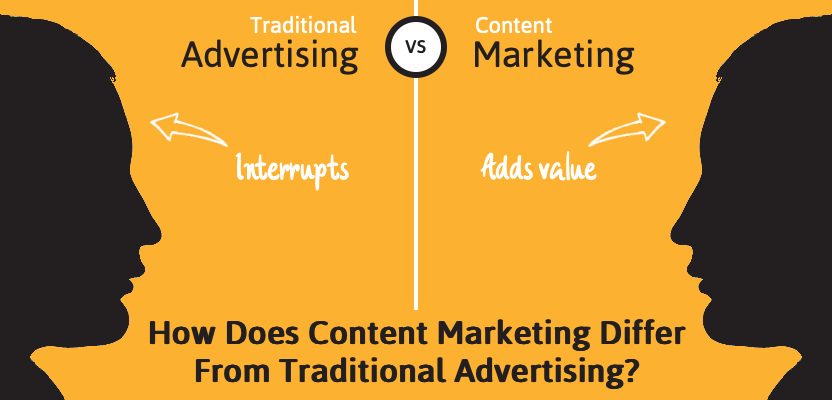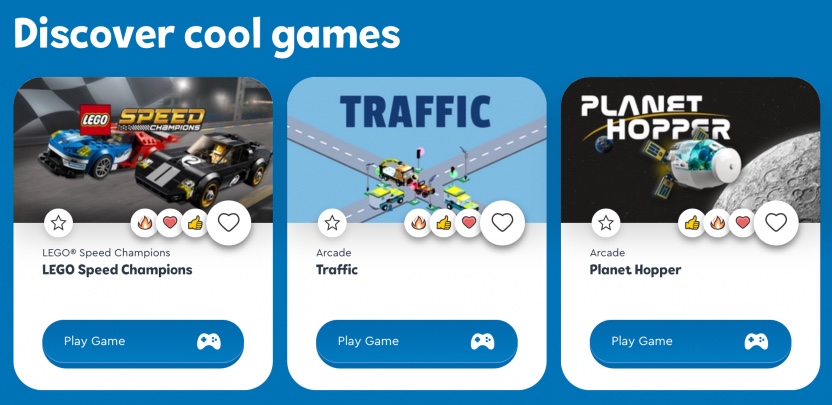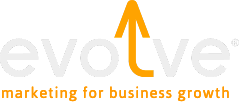
They share the same goal but differ vastly in strategy and execution, so how does content marketing differ from traditional advertising?
Table of Contents
- Content Marketing vs Traditional Advertising
- Traditional advertising
- Content marketing
- Examples of successful content marketing campaigns
- Advantages and disadvantages of content marketing vs traditional advertising
- TLDR
Content Marketing vs Traditional Advertising
Content marketing
Content marketing revolves around publishing engaging content to attract and retain a clearly defined target audience. It aims to build trust, establish thought leadership, and forge meaningful relationships with potential customers.
Traditional advertising
Traditional advertising promotes products or services by interrupting people while they’re doing something else – watching a movie, for example.
And that’s the nub of it…
Permission marketing
Content marketing is based on “permission” – on getting people to come to you for information they want. The concept of “permission marketing” was first introduced by Seth Godin in his book Permission Marketing: Turning Strangers Into Friends, And Friends Into Customers.
Interruption marketing
This differs from traditional advertising, which is based on “interruption” (aka interruption marketing). Traditional advertising is based on going to where people are and shoving your brand in front of them, e.g. a television advertisement that cuts into a TV movie.
Longevity
Once published, content marketing remains there forever. A blog post, white paper or video remains on its digital channel forever. You pay once, upfront, to develop your content piece and it lives on in perpetuity. Your goal is to attract customers to it, rather than pushing it on people through promotional tactics.
Fleeting
Once published, traditional advertising is gone forever. As soon as a 30-second television commercial or radio advertisement has aired, it’s gone. Forever. Print advertisements have a little more longevity, but not much. The second you stop paying, you stop being seen.
Big benefits
Content marketing campaigns are simpler than traditional advertising campaigns. They cost less, require less work, reach more potential customers, allow you to interact and build long-term relationships with prospects, and the rate of return is generally higher.
Traditional advertising strategies
Historically, businesses relied on television, radio, print, and billboards to deliver their brand messages to a mass audience. Traditional advertising strategies centred around interrupting consumers’ attention with persuasive messages, often using a hard-sell approach.
Evolving consumer behaviour has driven a shift towards more customer-centric approaches.
Customer-centric
Content marketing goes beyond mere product promotion by focusing on delivering valuable information, entertainment or education to your target audience. By providing useful content that aligns with your audience’s interests, content marketing cultivates trust, establishes credibility and positions your brand as an industry authority.
Company-centric
On the other hand, traditional advertising relies on intrusive tactics and aims to capture attention within a limited time frame. Commercials, banner ads and print advertisements often interrupt consumers’ experiences, hoping to generate immediate sales or brand recognition.
While traditional advertising can yield short-term results, it struggles to engage and build lasting relationships with today’s discerning consumers who value authenticity, transparency and meaningful interactions.
By embracing content marketing’s customer-centric approach, you can leverage storytelling, informative articles, engaging videos and interactive experiences to connect with your audience on a deeper level.
An understanding of the answer to the question, “How does content marketing differ from traditional advertising?” will help you make an informed decision when crafting your marketing strategy and help drive sustainable growth in your business.
Traditional advertising

Traditional advertising refers to the conventional methods of promotion through paid channels such as television, radio, print media, billboards and direct mail.
Its primary purpose is to create brand awareness, generate immediate sales and drive short-term results. It aims to persuade the audience to purchase a product or service by highlighting its features and benefits.
Traditional advertising relies on interrupting people’s attention to deliver persuasive messages and create brand awareness, often by employing catchy slogans, jingles, visually appealing graphics, and repetitive exposure to capture attention and prompt immediate action.
Traditional advertising often follows a structured and predefined format, adhering to time limits or space restrictions. Commercials have specific durations, print ads occupy fixed spaces, and radio spots adhere to allocated time slots.
Content marketing

Content marketing is a strategic marketing approach that focuses on building long-term relationships by sharing valuable and relevant content. Its purpose is to educate, entertain, inform or inspire your target audience, establishing trust and credibility over time.
It involves understanding your audience’s needs and interests and delivering information that addresses their pain points, provides solutions, or entertains them.
The primary objective of content marketing is to build trust, establish credibility and nurture long-term relationships with potential customers in order to drive profitable customer relationships.
Content marketing isn’t so much about blatantly promoting a product, or as I call it, the old ‘brag & boast’ approach. Instead, it takes a customer-centric approach and aims to provide value by offering informative articles, educational videos, engaging podcasts, interactive infographics, inspiring stories, or entertaining social media content.
By delivering valuable content consistently, you can position your business as a trusted authority in your industry and attract a loyal following.
Examples of successful content marketing campaigns
Here are a few notable examples of businesses that have achieved remarkable success through their content marketing campaigns…
Red Bull is renowned for its exceptional content marketing campaigns that revolve around extreme sports, adventure and a high-energy lifestyle. Through videos, articles and social media posts, Red Bull captures breathtaking stunts, inspiring stories of athletes, and exciting events, showcasing their association with adrenaline-pumping experiences.

GoPro leverages user-generated content to promote their action cameras. They encourage customers to share their exhilarating moments captured with GoPro cameras, creating a community-driven content ecosystem that resonates with adventure enthusiasts.

LEGO creates captivating storytelling experiences that resonate with both children and adults. Their campaigns feature animated movies, online games and social media content that bring LEGO sets to life, encouraging creativity and imagination. By leveraging user-generated content and partnerships with popular franchises like Star Wars and Marvel, LEGO has built a passionate community and fostered brand loyalty.

Dollar Shave Club disrupted the shaving industry with its humorous content marketing campaigns. Through witty videos and engaging blog content, they challenged traditional razor brands and built a loyal customer base. Their content addressed common frustrations and portrayed Dollar Shave Club as an affordable and convenient alternative, making it a viral sensation and driving significant brand growth.

Patagonia, the outdoor clothing and gear company, built a loyal customer base through content marketing campaigns centred around environmental sustainability and social responsibility. Their campaigns highlight their commitment to eco-friendly practices, fair trade and conservation efforts. Patagonia’s content inspires and educates consumers about the importance of protecting the environment, aligning their brand with conscious consumerism and attracting like-minded individuals.

These examples illustrate the power of content marketing in capturing attention, building brand loyalty, and driving customer engagement. Through strategic content creation, you can connect with your target audience authentically and establish a competitive edge.
Advantages and disadvantages of content marketing vs traditional advertising
Advantages of traditional advertising
- Wide Reach. Traditional advertising methods such as television, radio, print and outdoor advertising have the potential to reach a broad audience. This allows you to target a large population and create brand awareness on a mass scale.
- Tangible Presence. Traditional advertising often involves physical mediums such as billboards, posters and print ads, which provide a tangible presence for your brand.
- Established Audience. Traditional advertising channels often have well-established audience demographics, making it easier for you to target specific segments.
- Brand Familiarity. Traditional advertising methods have been around for a long time and are deeply ingrained in consumers’ lives. This can lead consumers to associate well-known brands with quality, reliability, and longevity.
Disadvantages of traditional advertising
- High Costs. Traditional advertising methods can be expensive, especially for prime spots during popular television shows, prominent billboards, or full-page print ads. This often proves prohibitive for smaller businesses with limited marketing budgets.
- Limited Targeting Options. Traditional advertising often lacks the precise targeting capabilities of digital advertising. You pay for their broad audience but your target audience is usually only a small subset of their audience, resulting in lower overall effectiveness.
- Difficulty in Tracking ROI. It can be challenging to measure the return on investment (ROI) of traditional advertising.
- Lack of Interactivity and Engagement. Traditional advertising is a one-way communication channel that doesn’t provide the same level of interactivity or immediate response mechanisms as digital platforms.
Advantages of content marketing
- Audience engagement. Content marketing focuses on delivering valuable and relevant content to the target audience, fostering engagement and interaction and enabling you to establish a deeper connection and build trust.
- Long-term impact. Content marketing aims to cultivate long-term relationships with your audience. Through consistent content creation, you can establish your brand as a thought leader and industry expert, resulting in increased brand loyalty and advocacy.
- Measurable results. Key performance indicators (KPIs) such as website traffic, social media engagement, conversion rates and customer feedback can provide valuable insights for optimising content strategies and tracking the effectiveness of campaigns.
- Search engine visibility. High-quality content optimised for search engines can improve your online visibility. By creating valuable content that aligns with search intent, you’ll rank higher in search engine results.
- Cost-effective. Compared to traditional advertising, content marketing is usually much more cost-effective.
Disadvantages of content marketing
- Time and resource-intensive. Content marketing requires significant time, effort and resources for creating high-quality content consistently. You’ll need to invest in skilled strategists and content creators to ensure effectiveness.
- Long-term commitment. Content marketing is not a quick fix; it requires consistent effort and a long-term commitment. Results may take time to materialise, as building trust and a loyal audience base takes patience and perseverance, but the payoff builds handsomely over time.
- Content saturation. The online space is filled with vast amounts of content, making it increasingly challenging to stand out. Businesses need to develop unique and valuable content that cuts through the noise and resonates with the target audience.
- Evolving algorithms and platforms. Success relies on understanding and adapting to the ever-changing algorithms and platforms of search engines and social media to maintain visibility and reach.
- Competition and quality expectations. As more businesses adopt content marketing, the competition for attention increases. To succeed, you must consistently deliver high-quality, valuable content that meets or exceeds the expectations of the audience.
TLDR
Understanding the basics of content marketing is essential if you want to connect with your audience in a meaningful and impactful way. By embracing content marketing, you can build trust, establish thought leadership and nurture long-term relationships with your target audience.
Content marketing allows you to provide value, educate, entertain, and address the needs and pain points of your audience, ultimately setting your business apart from competitors and driving engagement and meaningful results.
Remember, content marketing is a long-term investment that requires consistency, adaptability and a deep understanding of your audience. But embracing the power of content will deliver value and achieve your marketing goals.


